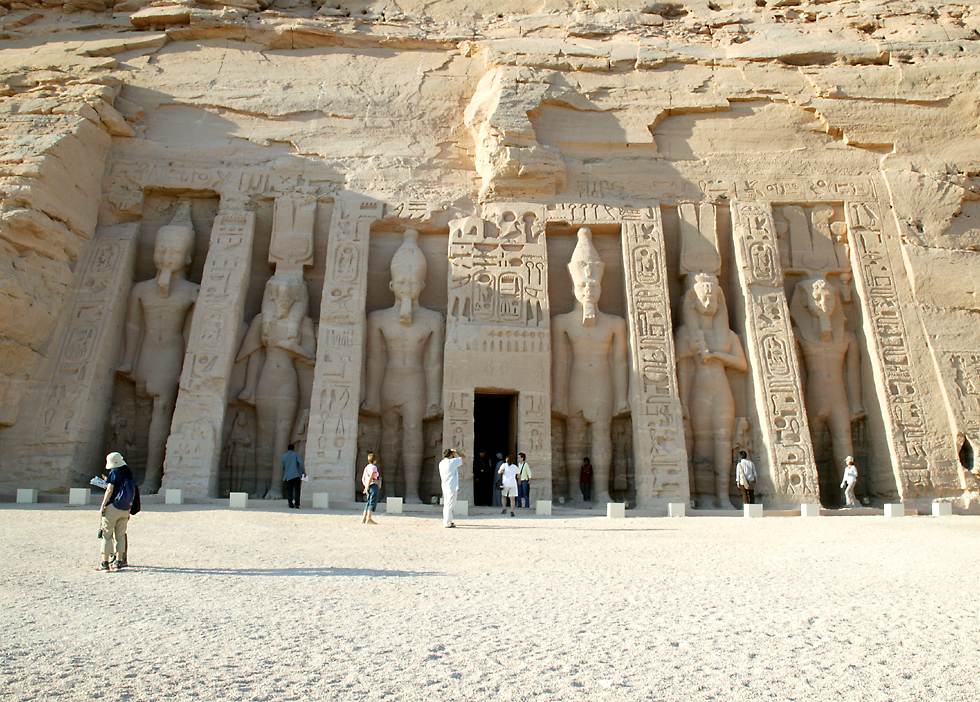The Abu Simbel temples are two massive rock temples in Abu Simbel (أبو سمبل in Arabic) in Nubia, southern Egypt. They are situated on the western bank of Lake Nasser, about 230 km southwest of Aswan (about 300 km by road). The complex is part of the UNESCO World Heritage Site known as the "Nubian Monuments," which run from Abu Simbel downriver to Philae (near Aswan).
The twin temples were originally carved out of the mountainside during the reign of Pharaoh Ramesses II in the 13th century BC, as a lasting monument to himself and his queen Nefertari, to commemorate his alleged victory at the Battle of Kadesh, and to intimidate his Nubian neighbors. However, the complex was relocated in its entirety in 1968, on an artificial hill made from a domed structure, high above the Aswan High Dam reservoir.
 The relocation of the temples was necessary to avoid their being submerged during the creation of Lake Nasser, the massive artificial water reservoir formed after the building of the Aswan High Dam on the Nile River. Abu Simbel remains one of Egypt's top tourist attractions.
The relocation of the temples was necessary to avoid their being submerged during the creation of Lake Nasser, the massive artificial water reservoir formed after the building of the Aswan High Dam on the Nile River. Abu Simbel remains one of Egypt's top tourist attractions.
Abu Simbel is the location of two towering sets of temples built by Ramesses II (c.1279-1213 B.C.E.) where he wished to demonstrate his power and his divine nature. Four colossal (65 feet/20 metres high) statues of him sit in pairs flanking the entrance. The head and torso of the statue to the left of the entrance fell during ancient times, probably the result of an earthquake.
Perhaps after the Giza pyramids, or coincident with them, the great temple of Abu Simbel presents the most familiar image of ancient Egypt to the modern traveler and reader. When the conservation efforts to preserve the temple from the soon-to be built High Aswan Dam and its rising waters were begun in the 1960s, images of the colossal statues filled newspapers and books. The temples were dismantled and relocated in 1968 on the desert plateau, 200 feet above and 600 feet west of their original location.
This temple faces the east, and Re-Horakhty, one manifestation of the sun god, is shown inside the niche directly above the entrance. The alignment of the temple is such that twice a year the sun's rays reach into the innermost sanctuary to illuminate the seated statues of Ptah, Amun-Re, Ramesses II, and Re- Horakhty. Abu Simbel is a day trip must and really is one of ancient Egypt's pinacle attractions.
At Abu Simbel, below the seat of one of the colossal statues of Ramesses II, is the sunk relief of the god Hapy, the personification of the Nile flood. Hapy is androgynous (both male and female characteristics), suggesting the fertility of the land which results from the Nile flood. This androgyny explains his pendant breasts and swollen belly. The centralized image of the lung and windpipe flanked by the two figures of Hapy illustrate the Egyptian concern for balance and order. The cartouche of Ramesses II sits directly above the lung and windpipe.


No comments:
Post a Comment